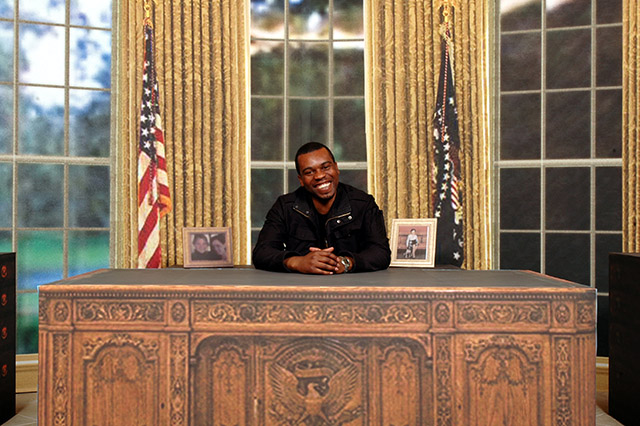|
Wallpaper pasted on some wooden elements 340 X 400 X 500 cm 2007 Two of my previous works, Bonneville and Place Franz Liszt, were already named after some specific places. Their goal was not to represent these places themselves but to explore the various means by which we comprenhend them. Bonneville was not about the city but its memory just as Place Franz Liszt was not about the real location but the various subjective fictions it gives rise to. Following the same approach, Oval office focuses on the presidential office's mythology. It is not easy to define the precise function of the oval office, a building that assumed a lot of different symbolic purposes during its long history. But one thing can be taken for granted : stricktly speaking, it has never been used as an office. The oval office can be seen as the contemporary equivalent of the ancient throne room. Here the power, an abstract idea, becomes something visible and tangible thanks to a set of symbolic elements (the presidential flag, the figure of the eagle, the unchanging furnitures...) that illustrates and confers it. This power is not just the objective power of a government; it tends to appear as a far more hyperbolic kind of power. By its shape, the office echoes the "omphalos", the so called "world's navel" the ancient Greeks situated in Delphos. The oval office equally intends to appear as the centre of the world, the place where the directives that decide on the world's destiny come from. This claim reached its peak in 1969 when the oval office became the place of an interplanetary call between president Nixon and the astronauts of the lunar mission "Apollo 11". Throughout the years, the oval office transformed from a real place into a scenery. Looking at its iconography, one is led to see it as a movie set, with its falsely insignificant props (family portraits, bust of Winston Churchill, Texas landscapes, bibelots, portrait of George Washington etc.) and its meticulously designed scenography that tries to look spontaneous. This set even has a stage machinery : a hidden door added to the desk by president Roosevelt to hide his disability then used by John John Kennedy to playfully appear in front of the cameras. The boom of television increased the spectacular dimension of the oval office by transforming it into a TV set, a pure simulacra. Then the Internet exponentially accelarated this transformation. An inversion occured : photographs of the oval office are no longer the representations of a real place. That's the oval office itself, vowed to a Deuleuzian "Becoming image", that seams to only exist through the images it generates. To realise this installation, I started by collecting hundreds of these images in order to reconstruct a global vision of the oval office out of them. But most of the time, these were portraits : The presidents or his guests were the main subject of the photo, the office only partially appeared in the background. So I was was like a huge puzzle, I was to put all this fragments together and to patienlty search for some new pictures that would provide the missing details. After I finally reconstructed a panoramic view, I printed it full size on some wallpaper widths and pasted it on some wooden volumes. My goal was not to offer a representation of the oval office but to give its images a physical dimension, to turn a set of immaterial images into a tangible space. The jpeg and gif images I collected being of very poor quality, the resulting place was itself low def, pixelated and blurry. This installation was first shown during the exhibition "Même heure, même endroit" at Abbaye de Maubuisson. This group exhibition gathered various artworks that dealt with the international situation. The installation Oval Office being located at the entrance of the exhibition, one was to cross it and to use its functional door several times in order to visit the exhibition. The central position of this ersatz echoed the presidential office's claim to be a control room for all the geopolitical issues but its obvious artificiality, the way it blatantly appears like a theatre set, indicates the obsolescence of this claim. Retrospectively, the installation give rise to a suspicion : Isn't the White House's Oval Office itself a decoy ?Back to top |
|
|






